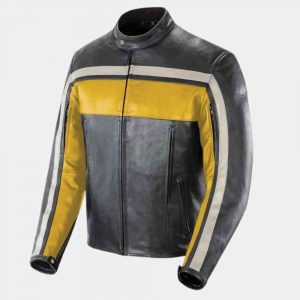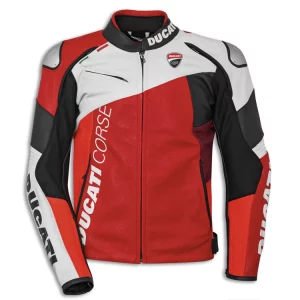Leather is a durable and elegant material that is known to last a long time. It is, however, a relatively rigid material at times that can prove challenging to work. Leather with a higher hardness is more durable. A soft leather jacket, on the other hand, is preferable to most people. In this regard, we need to figure out how to soften leather jackets without compromising their quality and without damaging them.
Different types of leather & their stiffness
The majority of leather does not come from cows, as you might think. Much leather is also sourced from animals like lambs, goats, pigs, buffaloes, and deer. Its rough texture makes it suitable as a protective material, such as motorcycle jackets.
Conversely, calfskin wears slowly and is very soft. The combination of goatskin’s softness and durability makes it an excellent alternative to both bovine and calfskin. Furthermore, goatskin is also water-repellent to a considerable degree, making it a precious and distinctive material. Lambskin leather is a material that high-end designers and fashion brands deem to be of the highest value.
An outline of the most popular hides and their softness:
Cowhide:
It is mainly made from cowhide and furniture is made from the standard average leather used. Because cowhide is the strongest and the most rigid leather, it is the best for furniture. Due to its heavy weight and toughness, it is not widely used in the fashion industry.
Deerskin leather:
Compared to cowhide leather, deerskin leather is softer and much more commonly used. Deerskin leather combines softness and airtightness through a unique particle structure. In addition to being warm in the winter and cool in the summer, deerskin leather has another distinctive feature. The leather is very durable and resistant to abrasion like most leathers.
Lambskin leather:
Leather made from lambskin is the softest leather out there. Since lambskin leather originates from a young animal, lambskin is soft since they haven’t fully matured. Leather made from lambskin has the butteriest texture. It is smooth fine-grained
8 Ways To Soften A Leather Jacket
- Apply alcohol and vaseline
- Dry clean the jacket
- Apply leather conditioner
- Use olive oil
- Get the jacket wet
- Wear the jacket more
- Apply mink oil
- Coconut Oil
Apply Rubbing Alcohol And Vaseline
To soften leather jackets and other leather apparel, rub alcohol and Vaseline are commonly used. The fibers of leather are penetrated more easily by rubbing alcohol because it penetrates the fibrous grain. This method involves adding rubbing alcohol to a spray bottle and spraying it one section at a time on the leather jacket.
Use a leather sponge or cloth to apply Vaseline to the jacket immediately after spraying with the solution. As the rubbing alcohol evaporates quickly, be sure to spread the Vaseline as soon as possible.
Dry Clean The Jacket
One method for softening a leather jacket is to dry clean it several times. When you dry clean the coat, it will become humid, and humidity helps the leather become pliable and flexible. Besides cleaning, they can also apply conditioners and oils to it, which will make it much softer and easier to wear. Depending on the size of the jacket, dry cleaning can cost anything between $40 and $70. You can also wash Leather Jacket at Home Easily.
Apply Leather Conditioner
Your new leather jacket will soften up quickly this way. The emollients and polymers in leather conditioners can penetrate the leather’s surface, reducing its stiffness. In addition to lowering stiffness, they can help keep your leather’s brilliant luster and shine. If you wear your jacket frequently or in warm, dry weather, it’s important to condition it regularly.
Use Olive Oil
Olive oil has been applied to leather products by many people. Here’s why. Your leather jacket’s grain will be softened and moisturized by rubbing olive oil on it. The natural saturated and unsaturated fats in olive oil can be used to soften leather fibers. As well, it can help protect the jacket from peeling and cracking by lightly conditioning it.
You can do this by applying olive oil to a leather sponge or lint-free cloth. Apply the oil to the jacket using circular motions after rubbing the cloth on it.
Get The Jacket Wet
It is also possible to soften a leather jacket by spraying it with water. You don’t want to over-saturate the jacket with this method, so don’t go overboard. If your jacket is still slightly damp, spray it enough with water to dampen it, then use a quality conditioner to finish it.
The moisture will simply roll off the grain if you have pre-treated your jacket with any waterproofing product. By moving your arms in different directions, you can help stretch out the jacket. Dry the jacket afterward.
Wear The Jacket More
Simply wearing your jacket more can help soften it up whether you do this at home or out in public. Your jacket will become more flexible and more comfortable the more you wear it. This is because the fibers of the grain will stretch as they are worn.
Apply Mink Oil
For centuries, leather products have been treated with mink oil. Mink oil provides leather fibers with lubrication and flexibility because it contains unsaturated fatty acids. Furthermore, it is pretty light and works well as a leather conditioner, as it penetrates deeply into the fibers of the grain without being too greasy.
In particular, leather that is new or dried out becomes softer thanks to the fat in the oil. Be sure to apply mink oil in small amounts to a leather sponge or soft cloth when applying to your new leather jacket. You should never use the oil directly to a coat, or it may stain it.
Apply Coconut Oil
Coconut oil is best applied to leather after it has been melted. Alternatively, you can heat it over a stove by placing it in a bowl and dipping the bowl in a bath of hot water. Then apply the oil to the leather with a sponge or some lint-free cloth in circular motions until it is thoroughly absorbed.
Stiff leather can be prevented by following the following tips:
- Make sure the products and apparel you wear are of high quality. The leather garments we offer at Leatherings are of high quality. A quality leather garment will last longer than a poor-quality garment since quality leather dries out more quickly.
- Your leather shouldn’t be left out in the sun for too long. UV rays from the sun can cause your skin to fade, dry out, and even crack. When you take off your leather clothes and footwear, store them inside.
- Drying leather products or garments is never a good idea. We all know that—dry wet leather naturally, out of direct sunlight, at room temperature, or outside.
- Maintaining adequate moisture levels while preventing stiffness requires you to condition leather periodically.
- Whenever possible, pick products that are made from top-grain or full-grain leather.
- You may want to apply olive oil to the leather if it feels dry and gently rubs it in until you no longer see it.
- Please refer to your leather garment’s care label for more information on how to To Soften Leather Jacket!
It is best to prevent the leather from becoming stiff through proper storage and care, but if it happens, it’s still not the end of the world. You can use any of the methods described above to restore your leather garment if any significant damage has occurred.
The manufacturer’s care instructions should always be followed for leather garments and some of the tips and suggestions do not apply to faux leather products.
Perfect Riding Gear by Leatherings
Yellow Black Motorcycle Jacket
Original price was: $299.00.$239.00Current price is: $239.00.
Black Yellow and White Leather Jacket
Original price was: $279.00.$210.00Current price is: $210.00.
Red Leather Motorcycle Jacket
Original price was: $498.00.$221.00Current price is: $221.00.
THOMPSON LEATHER MOTO JACKET
Original price was: $489.00.$249.00Current price is: $249.00.





